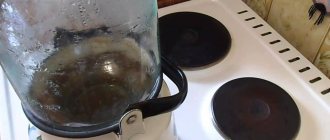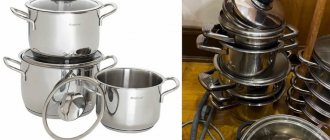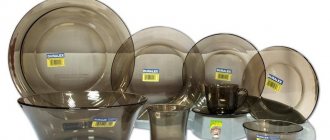Once upon a time, home canning was the only way to preserve the gifts of nature for the winter. Nowadays you can find all kinds of pickles and marinades in stores, but they are still inferior in taste to preparations made with your own hands according to old grandmother’s recipes. Knowledge of how to seal jars with screw-on lids will help any housewife diversify the family's diet without endangering the health of the family. After all, in order for stews, pickles, jams, and other masterpieces of talented chefs to be stored for a long time and bring pleasure, it is necessary not only to be very careful in preparing the products, but also to strictly adhere to the canning technology.
How to twist correctly and is a machine necessary for this?
Before using screw caps for their intended purpose, it is important to learn some subtleties and secrets:
- Before conservation begins, twist-off jars are sterilized. If containers for seaming are prepared together with lids, the sterilization temperature should not exceed 60 C. If jars are sterilized separately, the canning lids are first dipped in boiling water for two minutes.
- The prepared jar is filled with tasty contents and covered with a lid. In this case, the grooves on the rim should coincide with the twist lines on the can. The heated cap is scrolled along the thread line by hand. It covers the neck of the jar quite tightly, gradually cooling, ensuring maximum tightness.
When twisting, do not use too much force. Ignoring this condition can lead to overtightening of the thread and failure of the seam seal. Caps with broken threads are not suitable for use.
Also, twist-offs with traces of rust cannot be used for canning. Products with damage, dents and scratches are only suitable if the cans are not tightly closed (for example, for storing bulk products).
Screw caps (twist-off): pros and cons
Convenient, reusable lids that have their limitations. For example, they are only suitable for sealing cans with threads on the neck. The advantages include their relatively low cost and the ability to roll manually without a seaming machine. Screw caps can be used several times, but you will do this at your own peril and risk: if the sealing ring on the inside is damaged, the workpieces will deteriorate.
Twist-off lids are suitable for all types of products. But like tin, they have different coatings on the inside. For compotes and jams, a regular lid is suitable, but for salted preparations it is better to use specimens with a varnished coating.
Advantages:
- Ease of use. No seamer or key required.
- The shelf life of preservation is more than six months.
- Compared to tin lids, these lids are denser, and therefore there is less risk that they will swell.
- Possibility of repeated use, up to 3-4 times. But only if the cover is not rusty.
Flaws:
- The price of the lid is higher than that of a tin lid.
- Sometimes it is difficult to open such a lid. True, nowadays it’s not at all difficult to buy an opener specifically for such lids.
How to open a jar
The screw cap is easy to open.
To do this, turn the lid counterclockwise with a little effort. For those who do not have enough strength, a special opening machine will come to the rescue. If the opening process does not work, a match will help open the jar. The flame is slightly heated under the rim. When heated, the metal expands and the screw opens easily.
If your hands slip on the jar when opening, use household gloves or cover the jar with a plastic bag.
If the top of the jar is stuck, the following steps will help open it:
- Gently, so as not to break the glass, knock on the jar (top and side);
- place the jar on its side and lightly roll it over the table;
- soak the canned food in warm water for fifteen minutes.
If the screw cap is too tight, hot water will help open the jar. Preservation is placed under running water or wrapped in a wet hot towel. In this case, preservation must be at room temperature, otherwise the glass of the jar will burst. You can also carefully pry off the metal rim with a knife. The point is inserted between the neck and the lid and the metal rim is slightly pushed back. Depressurization will occur and the can will open easily.
Rolling algorithm
The first step is to figure out what not to do:
- Use a seamer. Twist-offs are easily screwed on by hand.
- Close cold jars with hot lids, and vice versa. It is important that both are well warmed up. If there is a large temperature difference, the container may burst.
Many housewives who are not yet quite experienced do not know how to roll up jars correctly. The main thing to consider here is one nuance - when canning, do not tighten the lid too much. Such actions can damage the threads (violate the geometry of the stops on the sides), which will not result in reliable sealing.
How to seal jars with screw caps:
- warm up both products (container and lid);
- fill the container with preserved food so that there is about a centimeter left to the top;
- using a napkin or pot holder, install the twist-off into the threaded grooves on the neck, carefully screw it in;
- turn the jar over and wrap it up.
Turning over cans serves two purposes. Firstly, this is control over tightness (a wet spot will appear around a poorly closed container), and secondly, this is the continuation of sterilization. The fact is that bacteria are killed not only by boiling. At temperatures below 100 degrees, sterilization continues, just more slowly. Syrups, brines and marinades for preservation are usually boiled, and the fruits are placed without heat treatment.
Wrapping the cans will help warm the food well and ensure maximum safety for their further storage.
Theoretically, you don’t have to turn the jars over, but just wrap them. But then the lids will not receive additional processing. In addition, heat escapes through metal very quickly. Therefore, it is advisable to place the inverted container on a fabric folded several times, a wooden board or other material with good thermal insulation.
You can do without turning and wrapping when rolling sweet preserves. The jam has already been boiled and does not require additional sterilization. The thick mass itself will hold the temperature for a long time; heat loss through the container in this case is insignificant. You can also close jars of jam and jams with thick plastic lids. To avoid mold, simply place a circle of paper soaked in alcohol on top of the product. If plaque appears, it will remain on the gasket, which is easy to remove.
Can I use a screw cap instead of a regular one?
Screw caps are many times better than regular ones, if only because they can be reused.
In addition, screw caps ensure high-quality canning of all types of pickled vegetables, mushrooms or jam. Such lids can be used for any jars, so many housewives have recently given preference to screw products rather than ordinary metal lids with rubber bands. You can ensure a long shelf life of preservation by adhering to some rules:
- when preserving foods with a high level of acidity, it is better to choose a twist-off with a thick layer of varnish;
- never overtighten the lid more than the thread allows (it will be damaged);
- twist the twist-off strictly along the thread line;
- Close the jars immediately after filling. It is important not to overfill the container (the contents should not reach 1 cm to the edges);
- Store jars in a dry, well-ventilated place. It is important to limit preservation from sudden temperature changes;
- Canned food with very low sugar content (or no sugar at all) is stored in a cool place (for example, a refrigerator);
- after the canned food with twist lids is closed, it needs to be turned over (check for sealing tightness);
- The product cannot be used for food if the lid is swollen, there is no cotton when opening for the first time, or the twist-off is covered with rust on the inside.
Pre-sterilization
No matter how thoroughly the lids are washed, they still need to be sterilized. The fact is that pathogenic bacteria die only at high temperatures. Boiling is guaranteed to kill them in a couple of minutes, processing in a slow cooker will require 10, and frying in the oven will take 15 minutes.
In addition to the destruction of pathogenic microorganisms, sterilization performs another function. During heating, the metal of the lid expands slightly, making the rolling process easier. When cooled, the fixation becomes denser, providing high sealing.
Methods for sterilizing metal caps:
- Boiling. Place the lid in a small container of boiling water for 2–5 minutes. It is important to ensure that the water boils all the time.
- Processing in a slow cooker. Set the cooking mode, pour in about a liter of preheated water, place inside the lid for 10–15 minutes. You can also steam jars at the same time.
- Warming up in the oven. Turn on and heat the device well. Place the washed lids on a baking sheet or rack with the inside facing up. Leave for 15–20 minutes.
- Steam treatment. You can simply hold the products over steam, which, of course, is not very convenient. To simplify the process, you will need a flat wire rack placed over a pan of boiling water. It is important to position the lids so that steam is guaranteed to reach their entire internal surface.
To remove products from boiling water or the oven, use a slotted spoon, tongs or a magnet. When canning, you should use a napkin, dish towel or oven mitts to avoid burning your hands. The jar should be covered immediately so that the metal does not have time to cool.
There are also options for processing lids without heating. They are soaked in a manganese solution or treated with alcohol. In these ways, it is indeed possible to achieve sterility, but the metal of the lid will remain cold, which will complicate the use of the product. In addition, there will be additional costs for chemicals.
Metal screw caps cannot be sterilized in a microwave oven.
In the oven
Boiling
Reuse
You can twist your favorite jam or any other product using a used twist lid.
The criteria for replacing the cover are:
- stains of rust or mold have appeared on the surface;
- the polymer inner layer was damaged;
- The side part with the thread is bent.
As long as the lid retains its original appearance, it is available for use. As practice has shown, it can be used for up to four years. Before reuse, the lid must undergo a sterilization procedure.
Should I throw away the caps after use?
After use, you don’t have to throw away the container, but simply wash it thoroughly, steam it and leave it for preservation. There are not so many correct ways to tighten a twist-off
- rinse the lid under warm water;
- steam over steam (temperature 60 degrees) or in hot water;
- check the presence of sealant inside, it should not be damaged after steaming;
- Screw the lid onto the neck of the jar tightly until it clicks.
After all such procedures are completed, a vacuum (dry) occurs in the jar and the products are stored for a long time. Opening it is simple: you need to twist the lid in the opposite direction.
Reasons for lids falling off jars
There are not as many of them as it might seem at first glance. Below are the top most common mistakes that lead to culinary fiasco among autoclave owners.
Sudden release of pressure in the autoclave
Sometimes impatience or inattention plays a bad joke on people. After cooking canned food in an autoclave, they thoughtlessly open the pressure release valve. The pressure in the apparatus drops sharply and the cans “detonate” one after another. The fact is that the difference in pressure in the autoclave and inside the jar becomes too great, the lid cannot stand it and falls off.
Despite the fact that the instructions for any autoclave say that it is strictly forbidden to suddenly release the pressure, people repeat this mistake over and over again. This is strictly PROHIBITED. It is necessary to wait until the autoclave has completely cooled down, and only then, having released the slight residual pressure, open the autoclave.
Violation of temperature and time regime
Often the cause of lids falling off jars is failure to comply with the cooking time and temperature. Sudden changes in temperature in the tank lead to pressure surges. The pressure (it is different in the autoclave and in the jar) tends to equalize, as a result, the lids fly off and the jars become deformed.
Equally important is the holding time. When canning, most harmful bacteria die, but if the required temperature is not maintained for the required time, then especially tenacious bacteria will survive. They are responsible for breaking lids and spoiling food in jars.
Poor quality lids
The most common reason, but no less common. If the lid was of poor quality, then it will not last long on the jar. There are cases when the lids have insufficiently strong stiffening ribs or the rubber seal is damaged. It is better not to use such instances.
As for the question of which lids are better, screw or regular tin, there is no consensus. In our opinion, there is not much difference, the main thing is to do everything correctly, use the products in accordance with GOST and seam them with a good seaming machine. Then the lids will remain in place, and the food in the jars will not spoil.
We have listed only 3 reasons; in reality, of course, there are many more. But these are the reasons that deserve attention, as they are the most frequent and unpleasant. The most important thing when using an autoclave is to follow the precautions written in the instructions; follow the recipe exactly; use high-quality related equipment.
So, the reasons for the caps falling off are considered. Now let's look at some tips to prevent this misfortune.
Is sterilization required?
Screw caps must be sterilized. Only in this case will they ensure long-term preservation.
Pay attention to the appearance of the lid. Do not use products with chips, rust, dents or cracks.
First, wash the twist-off with dish detergent. Then rinse them well with running water. After this, you can begin sterilization using one of three methods, which we will discuss below.
Plastic lids
It is quite difficult to find exact information about the possibility of repeated use of such lids: usually these products are sold in bulk in hardware stores. Some plastic lids have a note stating that it is advisable to use the product within a certain period of time, for example, five years. This means that if you have properly maintained the product (washed well, sterilized, dried and stored in a dry place), then there will be no particular harm from putting it on the jar again. But over time, such a cover loses its appearance, color and elasticity. Therefore, the desire or unwillingness to replace it is rather a matter of the housewife’s accuracy.
Recommendations for using screw caps in an autoclave
The principle of autoclaving with screw caps differs from the principle of autoclaving with SKO caps.
When cans are heated in an autoclave, excess pressure builds up inside the cans. This pressure is compensated, in the case of using SKO lids, by external pressure (pressure inside the autoclave and outside the jar). If these pressures remain equal, the autoclaving process is successful. In the case of using screw caps, there is no need to compensate internal pressure in the jars, because a special screw cap gasket allows excess pressure to be released from the can, and the pressures inside and outside the can are automatically equalized. In this case, since the pressure inside the jar grows faster than the external one, the pressure is released from the jar and the absorption of the external environment (the contents of the autoclave) into the jar is completely eliminated. During the cooling stage of the autoclave, the pressure inside the jar decreases, and the lid, under the influence of the resulting vacuum inside the jar, is attracted to the neck of the jar, thereby reliably sealing the canned food.
Based on the features of this process, we can give a number of recommendations for the use of screw caps in an autoclave:
In this article, we have provided recommendations for preparing jars and lids before autoclaving. All these requirements remain the same as for conventional canning: the jars must be thoroughly washed and sterilized, the lids must be kept in boiling water for 3-5 minutes.
By adhering to these recommendations and observing autoclaving modes, you will get truly tasty and healthy canned food!
Source
How to seam a can with a seamer (key)
Manual seaming machine
This method is familiar to all of us; it is what many of us observed in childhood, when our mother or grandmother prepared canned food and screwed the lids onto the jars with a strange object - a seaming machine. It is also called a key. Sometimes, by the way, the wrench is also used when rolling up screw caps when there is not enough manual strength. But most often it is needed for seaming lids with an elastic band.
How to properly roll a jar with a manual machine: - First you need to install a sterilized lid on the jar, press it with a seaming machine and start rolling it in a clockwise circular motion. — After several revolutions, turn the key handle several times. This is necessary to reduce the diameter of the roller. Then move carefully clockwise again. — The main thing in this process is to screw the jar tightly, but not damage it.
Snail key
Visually, it is similar to a manual typewriter, but differs from it in its operating principle. The snail key rotates not along the central axis, but in a spiral.
Mechanism of operation: — The lid must be pressed tightly onto the jar with one hand, and the other hand must begin to be rolled up, guiding the device in a spiral. — For a tighter twist, it is better to rotate the handle clockwise, reducing the diameter along which the mechanism moves. — When the dipstick moves the shortest distance to the center, you need to unscrew the handle counterclockwise and remove the snail key.
Semi-automatic
It is a regular seaming machine with horizontal and vertical handles designed for holding and screwing the lids. The latch has a thread along which the mechanism rotates, pressing the metal against the glass. To tighten it, just install the device and turn it until it stops.
Warming up in the oven
This method is convenient because you can sterilize both twist-offs and jars together.
Heat the oven to +50°. Place screw caps and glass jars in it. After 10 minutes, increase the temperature to +100° and sterilize the products for another 15 minutes.
Be sure to increase the temperature gradually. Otherwise, glass jars may burst. Also remember that containers and lids for preservation cannot be sterilized in a microwave oven.
A Brazilian travels 36 km by bike every day to take his loved one home.
Lost weight: what Sofia Tarasova sacrificed for the sake of “VIA Gra” (new photos)
“We are still friends”: Derevianko commented on the breakup with his wife
Recommendations and tips for preventing caps from falling off
These tips will help you avoid trouble with lids while canning.
Pressure cassettes in an autoclave
Such an attribute in an autoclave as a pressure cassette has two big advantages at once. Firstly, it securely presses the lid to the jar, preventing it from flying off. Secondly, the cassette also secures the can itself. And this is important, given that there is considerable pressure and high temperature inside the autoclave.
Use cassettes, friends, they definitely won’t make things worse.
Water level in the autoclave
Everything is simple here - the water should completely hide the cans of food, but at the same time its level should not reach the top by 3-4 centimeters. This is done to ensure a smooth increase in pressure, since the remaining air is more easily compressed than liquid. This saves the jars and autoclave from damage and unnecessary stress. Complete immersion of the cans in the liquid results in more uniform heating and increased pressure.
Filling food jars
There is nothing complicated here either. We don't fill the jars to capacity. We place the products tightly enough, but leave a small gap of 2-3 cm to the lid. The rule is simple, but if you don’t follow it, the lids will certainly come off.
The fact is that when heated, the products in the jar expand, and this air space is a kind of airbag that prevents the jars from swelling and other troubles.
Proper preparation of lids
The correct technology for rolling lids is no less important. Before the lid process, it is recommended to keep it in boiling water for at least 30 seconds. This will help the polymer rings and seals soften. Thanks to this, sealing will be much higher.
Autoclave heating
Well, the last recommendation. More likely not even a recommendation, but just advice. You should not use excessively fast heating of the device, even if your tile allows it. In general, we would not recommend using power more than 1 kW. This will lead to sudden pressure changes in the device. But for cans this is completely undesirable. It is also not recommended to cool the autoclave quickly. If you have not only a lot of time, but also the same amount of patience, then it is better to let the tank cool naturally. Otherwise, during rapid cooling, the cans will “detonate”, unable to withstand the temperature difference.
Of course, the list of recommendations can be continued for a long time. But these tips will be enough to avoid broken lids, shed tears and frustration due to wasted time.
Important! Use only high-quality equipment for canning. In our online store you can find all the components for safe and convenient canning:
All products are certified and comply with GOST standards.
Source
Using a tin can
Tin cans are used for canning and packaging products:
- • ready-made meat dishes (stew, tourist’s breakfast, chakhokhbili and others)
- • canned fish and seafood
- • ready-made main courses (pilaf, porridge)
- • pates
- • caviar
- • vegetables, vegetable mixtures and salads
- • food for cats and dogs
For several years now, tin cans of various sizes have been in high demand for packaging and holiday decoration of gifts and surprises. These are gifts for men and women, souvenirs from the resort, surprises for loved ones.











